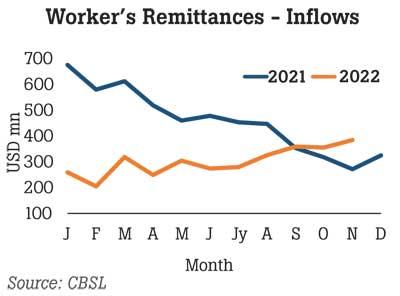Reply To:
Name - Reply Comment
Worker remittances income continued to gather steam as such inflows in November recorded the highest levels in sixteen months after a brief setback in October.
sixteen months after a brief setback in October.
The data available through November showed Sri Lanka had received US$ 384.4 million from those working abroad, bringing the eleven-month income from remittances to US$ 3,313.9 million.
The last time Sri Lanka earned higher than November remittances was back in August 2021, which came in at US$ 446.6 million.
November and December typically bring in higher than normal inflows as Sri Lankans working abroad send more money to their families at home than other times to support them during the year-end festive season.
While the November inflow indicated an increase from the US$ 271.4 million received in the same month a year ago, the cumulative inflows are still down as much as 35.9 percent to US$ 3, 313.9 million from the corresponding period in 2021.
This was due to a large segment of migrants choosing informal channels to repatriate their earnings back into the country from middle part of last year, during when the country started feeling the shortages in foreign currency.
Up until March this year Sri Lanka maintained the official exchange rate at Rs.203 per dollar while the informal market was offering much higher rates. As a result, a lot of migrant workers resorted to unofficial methods such as Hawala and Undiyal to send back their moneys to their loved ones at a higher exchange rate.
Until May 2021, Sri Lanka was able to maintain a 13-month long continuous growth in remittances after receiving a record high remittance income of slightly over US$ 7.1 billion in 2020.
Since then, remittances, Sri Lanka’s single largest foreign exchange income source, together with US$ 5.0 billion large tourism industry, which for the most part held the external sector and the Sri Lankan economy relatively stable, grew weaker due to the pandemic, finally plunging the economy an unprecedented turmoil.
At the current level of inflows, Sri Lanka could end up with around US$ 3,700 million in total remittances by the end of 2022, about half of what the country received in 2020 and about a third below the 2021 levels of US$ 5.5billion.
The Central Bank recently identified that there had also been an element of over-reporting by banks on worker remittances in recent years as there had been instances where banks had included remittances from other sources as part of remittances from workers.